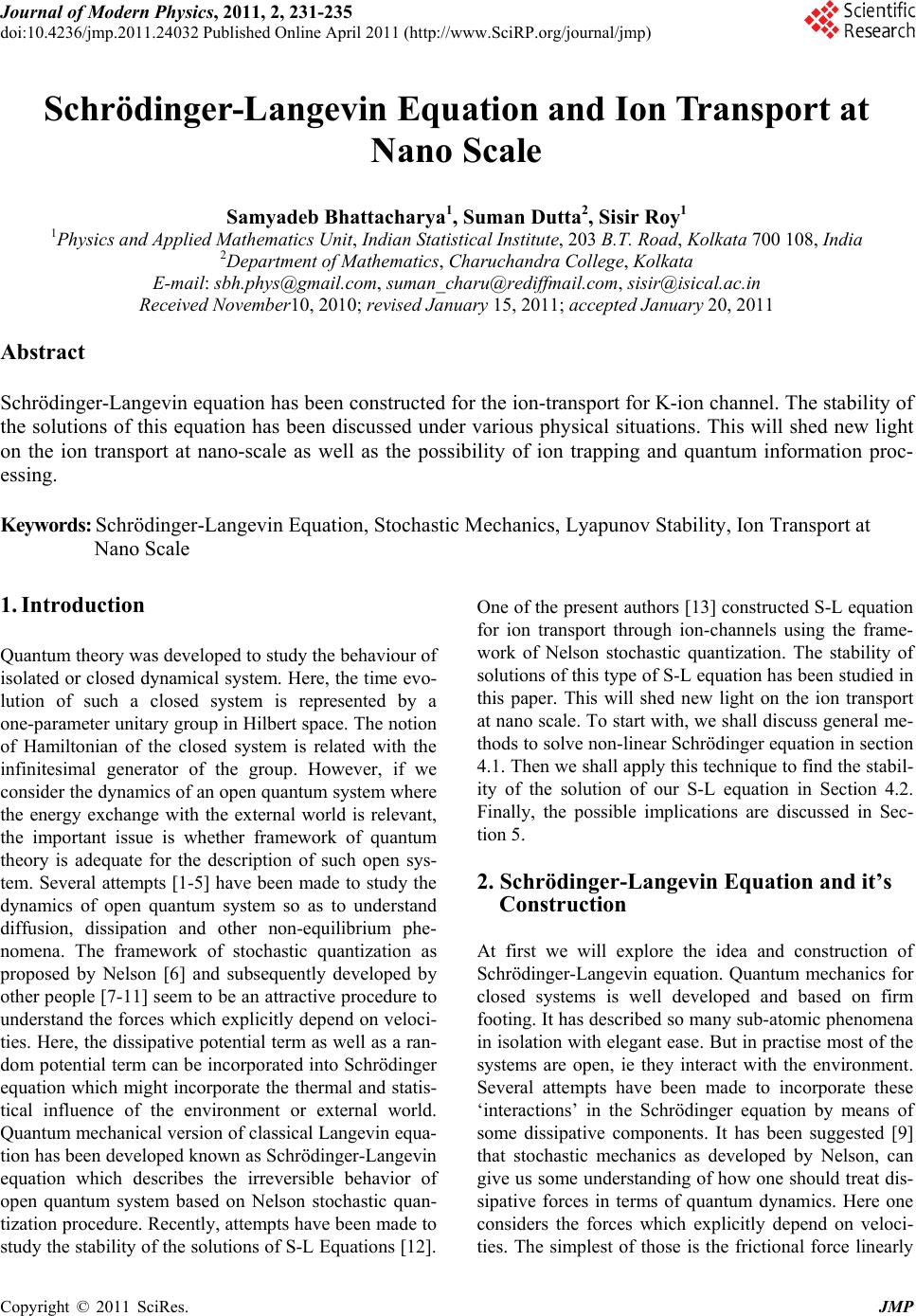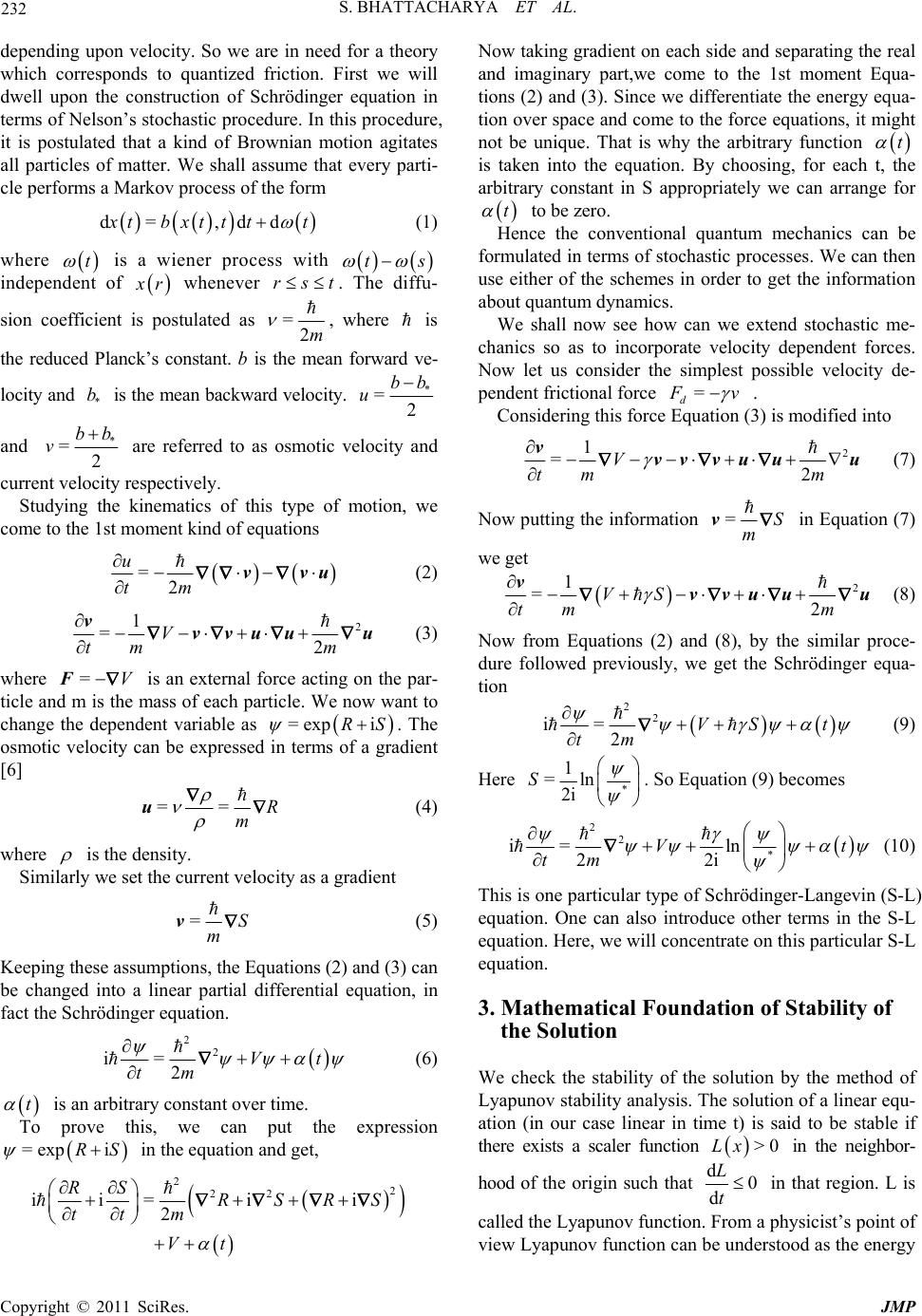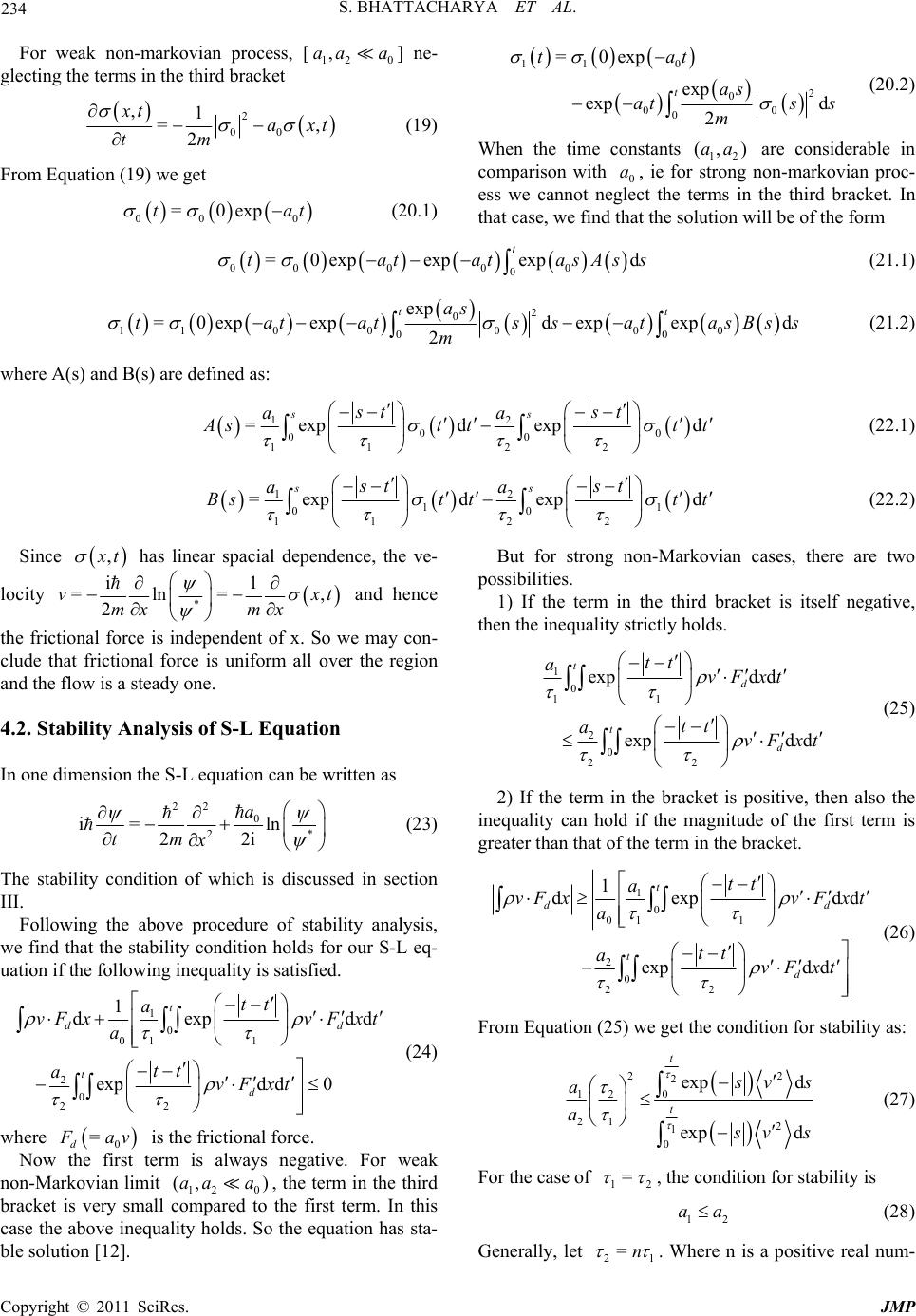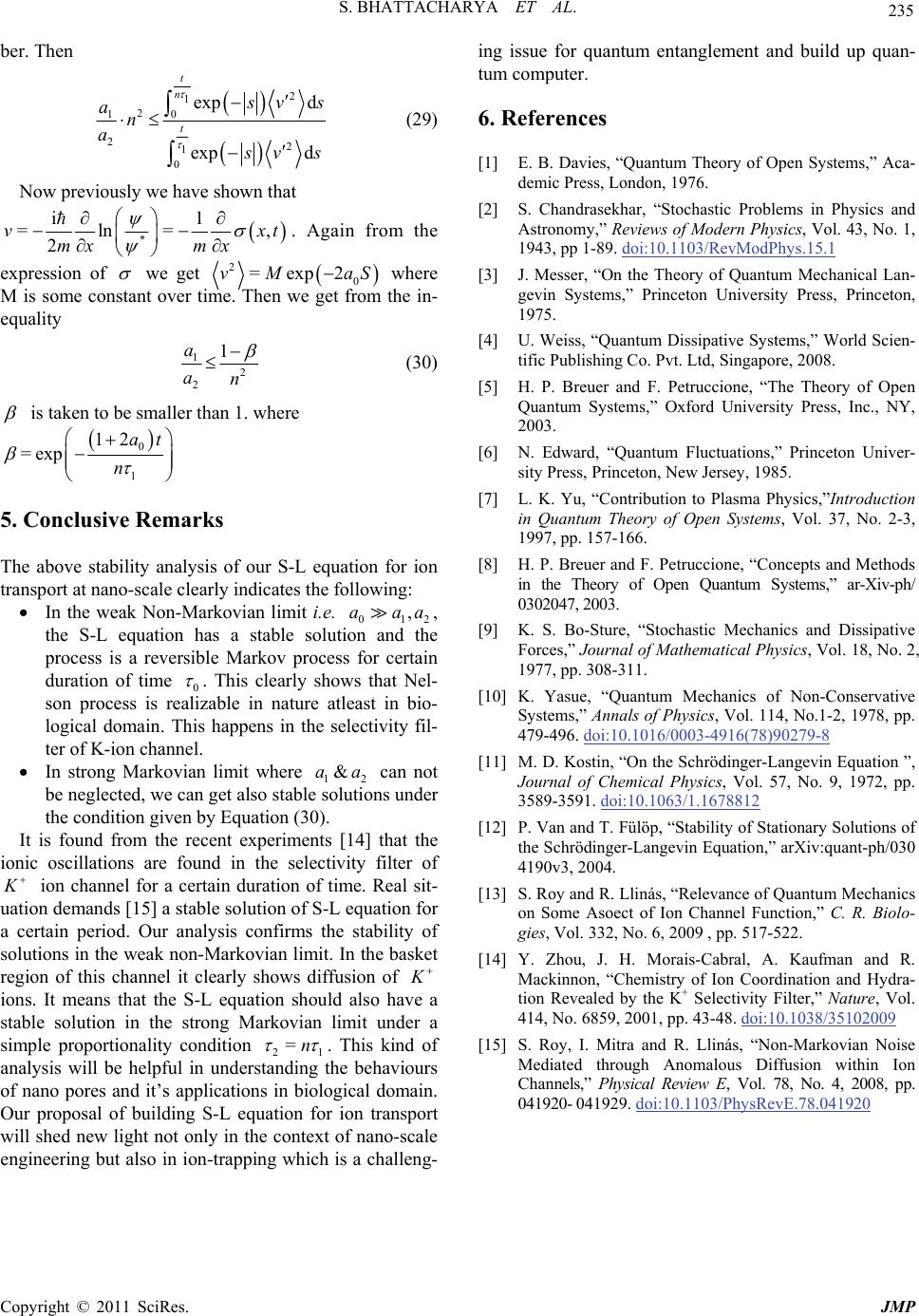Paper Menu >>
Journal Menu >>
 Journal of Modern Physics, 2011, 2, 231-235 doi:10.4236/jmp.2011.24032 Published Online April 2011 (http://www.SciRP.org/journal/jmp) Copyright © 2011 SciRes. JMP Schrödinger-Langevin Equation and Ion Transport at Nano Scale Samyadeb Bhattacharya1, Suman Dutta2, Sisir Roy1 1Physics and Applied Mathematics Unit, Indian Statistical Institute, 203 B.T. Road, Kolkata 700 108, India 2Department of Mathematics, Charuchandra College, Kolkata E-mail: sbh.phys@gmail.com, suman_charu@rediffmail.com, sisir@isical.ac.in Received November10, 2010; revised January 15, 2011; accepted January 20, 2011 Abstract Schrödinger-Langevin equation has been constructed for the ion-transport for K-ion channel. The stability of the solutions of this equation has been discussed under various physical situations. This will shed new light on the ion transport at nano-scale as well as the possibility of ion trapping and quantum information proc- essing. Keywords: Schrödinger-Langevin Equation, Stochastic Mechanics, Lyapunov Stability, Ion Transport at Nano Scale 1. Introduction Quantum theory was developed to study the behaviour of isolated or closed dynamical system. Here, the time evo- lution of such a closed system is represented by a one-parameter unitary group in Hilbert space. The notion of Hamiltonian of the closed system is related with the infinitesimal generator of the group. However, if we consider the dynamics of an open quantum system where the energy exchange with the external world is relevant, the important issue is whether framework of quantum theory is adequate for the description of such open sys- tem. Several attempts [1-5] have been made to study the dynamics of open quantum system so as to understand diffusion, dissipation and other non-equilibrium phe- nomena. The framework of stochastic quantization as proposed by Nelson [6] and subsequently developed by other people [7-11] seem to be an attractive procedure to understand the forces which explicitly depend on veloci- ties. Here, the dissipative potential term as well as a ran- dom potential term can be incorporated into Schrödinger equation which might incorporate the thermal and statis- tical influence of the environment or external world. Quantum mechanical version of classical Langevin equa- tion has been developed known as Schrödinger-Langevin equation which describes the irreversible behavior of open quantum system based on Nelson stochastic quan- tization procedure. Recently, attempts have been made to study the stability of the solutions of S-L Equations [12]. One of the present authors [13] constructed S-L equation for ion transport through ion-channels using the frame- work of Nelson stochastic quantization. The stability of solutions of this type of S-L equation has been studied in this paper. This will shed new light on the ion transport at nano scale. To start with, we shall discuss general me- thods to solve non-linear Schrödinger equation in section 4.1. Then we shall apply this technique to find the stabil- ity of the solution of our S-L equation in Section 4.2. Finally, the possible implications are discussed in Sec- tion 5. 2. Schrödinger-Langevin Equation and it’s Construction At first we will explore the idea and construction of Schrödinger-Langevin equation. Quantum mechanics for closed systems is well developed and based on firm footing. It has described so many sub-atomic phenomena in isolation with elegant ease. But in practise most of the systems are open, ie they interact with the environment. Several attempts have been made to incorporate these ‘interactions’ in the Schrödinger equation by means of some dissipative components. It has been suggested [9] that stochastic mechanics as developed by Nelson, can give us some understanding of how one should treat dis- sipative forces in terms of quantum dynamics. Here one considers the forces which explicitly depend on veloci- ties. The simplest of those is the frictional force linearly  232 S. BHATTACHARYA ET AL. depending upon velocity. So we are in need for a theory which corresponds to quantized friction. First we will dwell upon the construction of Schrödinger equation in terms of Nelson’s stochastic procedure. In this procedure, it is postulated that a kind of Brownian motion agitates all particles of matter. We shall assume that every parti- cle performs a Markov process of the form d= ,dd x tbxttt t (1) where is a wiener process with t ts independent of x r whenever . The diffu- rst sion coefficient is postulated as =2m , where is the reduced Planck’s constant. b is the mean forward ve- locity and is the mean backward velocity. * b* =2 bb u and * =2 bb v are referred to as osmotic velocity and current velocity respectively. Studying the kinematics of this type of motion, we come to the 1st moment kind of equations =2 u tm vv u (2) 2 1 =2 V tm m vvvuu u (3) where =V F is an external force acting on the par- ticle and m is the mass of each particle. We now want to change the dependent variable as . The osmotic velocity can be expressed in terms of a gradient [6] =exp iRS ==R m u (4) where is the density. Similarly we set the current velocity as a gradient =S m v (5) Keeping these assumptions, the Equations (2) and (3) can be changed into a linear partial differential equation, in fact the Schrödinger equation. 2 2 i= 2Vt tm (6) t is an arbitrary constant over time. To prove this, we can put the expression in the equation and get, =exp iRS 22 22 ii= ii 2 RS RSRS tt m Vt Now taking gradient on each side and separating the real and imaginary part,we come to the 1st moment Equa- tions (2) and (3). Since we differentiate the energy equa- tion over space and come to the force equations, it might not be unique. That is why the arbitrary function t is taken into the equation. By choosing, for each t, the arbitrary constant in S appropriately we can arrange for t to be zero. Hence the conventional quantum mechanics can be formulated in terms of stochastic processes. We can then use either of the schemes in order to get the information about quantum dynamics. We shall now see how can we extend stochastic me- chanics so as to incorporate velocity dependent forces. Now let us consider the simplest possible velocity de- pendent frictional force = d F v . Considering this force Equation (3) is modified into 2 1 =2 V tm m vvvvu uu (7) Now putting the information =S m v in Equation (7) we get 2 1 =2 VS tm m vvvuu u (8) Now from Equations (2) and (8), by the similar proce- dure followed previously, we get the Schrödinger equa- tion 2 2 i= 2VS t tm (9) Here * 1 =ln 2i S . So Equation (9) becomes 2 2 * i= ln 22i Vt tm (10) This is one particular type of Schrödinger-Langevin (S-L) equation. One can also introduce other terms in the S-L equation. Here, we will concentrate on this particular S-L equation. 3. Mathematical Foundation of Stability of the Solution We check the stability of the solution by the method of Lyapunov stability analysis. The solution of a linear equ- ation (in our case linear in time t) is said to be stable if there exists a scaler function in the neighbor- >0Lx hood of the origin such that dL0 dt in that region. L is called the Lyapunov function. From a physicist’s point of view Lyapunov function can be understood as the energy Copyright © 2011 SciRes. JMP  S. BHATTACHARYA ET AL. Copyright © 2011 SciRes. JMP 233 of the system. We know that for stable equilibrium the potential energy is minimum. So if the total time deriva- tive of the Lyapunov function is negative, it means that the the rate of change of energy is negative, i.e. the en- ergy of the system is tending to it’s minimum. tive frictional force 0 = d F av where * =ln 2i v is the velocity. The Lyapunov function taken as the energy difference between present state and the stationary state, is ex- pressed as Van & Fülop et al. [12] have taken a non-linear S-L equation of the form 2 21 ,= d 222 s LV EV v v (12) 2 20 * i= ln 22i a V tm (11) where is the probability density and s E is the en- ergy of the stationary state. Here V is the conservative potential contribution and the non-linear term is the contribution due to the dissipa- The total time derivative of L is found to be 2ln d=d d2 4 qs d LVVEA vFV t v v v d (13) q V is the quantum potential. Now it is shown that d d L t derivative of L is calculated. The condition for stability can be derived by stating the total time derivative of L to be negative. is found to be negative providing the second term in the right hand side is negative. Since this term is the rate of change of energy due to the frictional force, it can be taken as negative. 4. Schrödinger-Langevin Equation Following Van & Fülop et al., we take the expectation value of the energy difference of the present and the sta- tionary states as the Lyapunov function. Then we calcu- late the first variation of L and from that the total time It has been found that Schrodinger-Langevin equation can be constructed for the case of ionic diffusion along K ion channels [13]. The Schrodinger-Langevin equation describing the ionic diffusion is as follows 22 0 2* 12 ** 00 11 22 i = ln 22 expdlnexpdln 2i tt a V tm i x tt tt aa tt (14) tial V = 0. Here we will try to find the solution of Equation (14) and check the stability of it by the method of Lyapunov stability analysis. Let the solution be of the form i ,=exp , x t xt . [ (x,t) is real] 4.1. Solution of the S-L Equation Putting in the Equation (14) we get We will try to find the solution of (14) following the method developed by Kostin [11] to find the solution of nonlinear Schrodinger-Langevin equation for the poten- 2 2=0 x (15) 2 12 000 11 22 1 =exp dexp d 2 tt tt tt aa at tmx t (16) From Equation (15) we get 01 ,= x ttx t (17) From Equation (16) we get 212 00 00 11 22 1 =,exp dexp 2 tt tt tt aa ta xttt tm d (18)  S. BHATTACHARYA ET AL. Copyright © 2011 SciRes. JMP 234 For weak non-markovian process, [] ne- glecting the terms in the third bracket 12 0 ,aa a 2 00 ,1 =, 2 xt axt tm 0 at (19) From Equation (19) we get 00 =0expt (20.1) 11 0 2 0 00 0 =0exp exp exp d 2 t tat as ats s m (20.2) When the time constants 12 are considerable in comparison with 0, ie for strong non-markovian proc- ess we cannot neglect the terms in the third bracket. In that case, we find that the solution will be of the form (, )aa a 0000 0 0 =0expexpexpd t tatatas Ass (21.1) 2 0 110000 0 00 exp =0expexpdexpexpd 2 tt as tatatssatas m Bss (21.2) where A(s) and B(s) are defined as: 12 0 00 11 22 =exp dexp d ss st st aa 0 A stt tt (22.1) 12 1 00 11 22 =exp dexp d ss st st aa Bstt tt 1 (22.2) Since , x t has linear spacial dependence, the ve- locity * i1 =ln= 2 v mx mx , xt and hence the frictional force is independent of x. So we may con- clude that frictional force is uniform all over the region and the flow is a steady one. 4.2. Stability Analysis of S-L Equation In one dimension the S-L equation can be written as 22 0 2 i= ln 22i a tm x* (23) The stability condition of which is discussed in section III. Following the above procedure of stability analysis, we find that the stability condition holds for our S-L eq- uation if the following inequality is satisfied. 1 0 01 1 2 0 22 1 dexp expdd0 t d t d tt a vF xvF xt a tt avFxt dd d (24) where 0 = d F av is the frictional force. Now the first term is always negative. For weak non-Markovian limit 12 0 , the term in the third bracket is very small compared to the first term. In this case the above inequality holds. So the equation has sta- ble solution [12]. (, )aa a But for strong non-Markovian cases, there are two possibilities. 1) If the term in the third bracket is itself negative, then the inequality strictly holds. 1 0 11 2 0 22 expdd expdd t d t d tt avFxt tt avFxt (25) 2) If the term in the bracket is positive, then also the inequality can hold if the magnitude of the first term is greater than that of the term in the bracket. 1 0 01 1 2 0 22 1 d expdd expdd t dd t d tt a vF xvF xt a tt avFxt (26) From Equation (25) we get the condition for stability as: 22 2 0 12 21 2 1 0 exp d exp d t t s vs a a s vs (27) For the case of 1 =2 , the condition for stability is 1 aa2 1 (28) Generally, let 2 =n . Where n is a positive real num-  S. BHATTACHARYA ET AL. 235 ber. Then 2 1 20 1 22 1 0 exp d exp d t n t s vs an a s vs (29) Now previously we have shown that * i1 =ln= 2 vx mx mx ,t . Again from the expression of we get 2 0 =exp2vM aS where M is some constant over time. Then we get from the in- equality 1 2 2 1 a an (30) is taken to be smaller than 1. where 0 1 12 = expat n 5. Conclusive Remarks The above stability analysis of our S-L equation for ion transport at nano-scale clearly indicates the following: In the weak Non-Markovian limit i.e. 012 ,, the S-L equation has a stable solution and the process is a reversible Markov process for certain duration of time 0 aaa . This clearly shows that Nel- son process is realizable in nature atleast in bio- logical domain. This happens in the selectivity fil- ter of K-ion channel. In strong Markovian limit where 12 &aa can not be neglected, we can get also stable solutions under the condition given by Equation (30). It is found from the recent experiments [14] that the ionic oscillations are found in the selectivity filter of K ion channel for a certain duration of time. Real sit- uation demands [15] a stable solution of S-L equation for a certain period. Our analysis confirms the stability of solutions in the weak non-Markovian limit. In the basket region of this channel it clearly shows diffusion of K ions. It means that the S-L equation should also have a stable solution in the strong Markovian limit under a simple proportionality condition 21 =n . This kind of analysis will be helpful in understanding the behaviours of nano pores and it’s applications in biological domain. Our proposal of building S-L equation for ion transport will shed new light not only in the context of nano-scale engineering but also in ion-trapping which is a challeng- ing issue for quantum entanglement and build up quan- tum computer. 6. References [1] E. B. Davies, “Quantum Theory of Open Systems,” Aca- demic Press, London, 1976. [2] S. Chandrasekhar, “Stochastic Problems in Physics and Astronomy,” Reviews of Modern Physics, Vol. 43, No. 1, 1943, pp 1-89. doi:10.1103/RevModPhys.15.1 [3] J. Messer, “On the Theory of Quantum Mechanical Lan- gevin Systems,” Princeton University Press, Princeton, 1975. [4] U. Weiss, “Quantum Dissipative Systems,” World Scien- tific Publishing Co. Pvt. Ltd, Singapore, 2008. [5] H. P. Breuer and F. Petruccione, “The Theory of Open Quantum Systems,” Oxford University Press, Inc., NY, 2003. [6] N. Edward, “Quantum Fluctuations,” Princeton Univer- sity Press, Princeton, New Jersey, 1985. [7] L. K. Yu, “Contribution to Plasma Physics,”Introduction in Quantum Theory of Open Systems, Vol. 37, No. 2-3, 1997, pp. 157-166. [8] H. P. Breuer and F. Petruccione, “Concepts and Methods in the Theory of Open Quantum Systems,” ar-Xiv-ph/ 0302047, 2003. [9] K. S. Bo-Sture, “Stochastic Mechanics and Dissipative Forces,” Journal of Mathematical Physics, Vol. 18, No. 2, 1977, pp. 308-311. [10] K. Yasue, “Quantum Mechanics of Non-Conservative Systems,” Annals of Physics, Vol. 114, No.1-2, 1978, pp. 479-496. doi:10.1016/0003-4916(78)90279-8 [11] M. D. Kostin, “On the Schrödinger-Langevin Equation ”, Journal of Chemical Physics, Vol. 57, No. 9, 1972, pp. 3589-3591. doi:10.1063/1.1678812 [12] P. Van and T. Fülöp, “Stability of Stationary Solutions of the Schrödinger-Langevin Equation,” arXiv:quant-ph/030 4190v3, 2004. [13] S. Roy and R. Llinás, “Relevance of Quantum Mechanics on Some Asoect of Ion Channel Function,” C. R. Biolo- gies, Vol. 332, No. 6, 2009 , pp. 517-522. [14] Y. Zhou, J. H. Morais-Cabral, A. Kaufman and R. Mackinnon, “Chemistry of Ion Coordination and Hydra- tion Revealed by the K+ Selectivity Filter,” Nature, Vol. 414, No. 6859, 2001, pp. 43-48. doi:10.1038/35102009 [15] S. Roy, I. Mitra and R. Llinás, “Non-Markovian Noise Mediated through Anomalous Diffusion within Ion Channels,” Physical Review E, Vol. 78, No. 4, 2008, pp. 041920- 041929. doi:10.1103/PhysRevE.78.041920 Copyright © 2011 SciRes. JMP |

